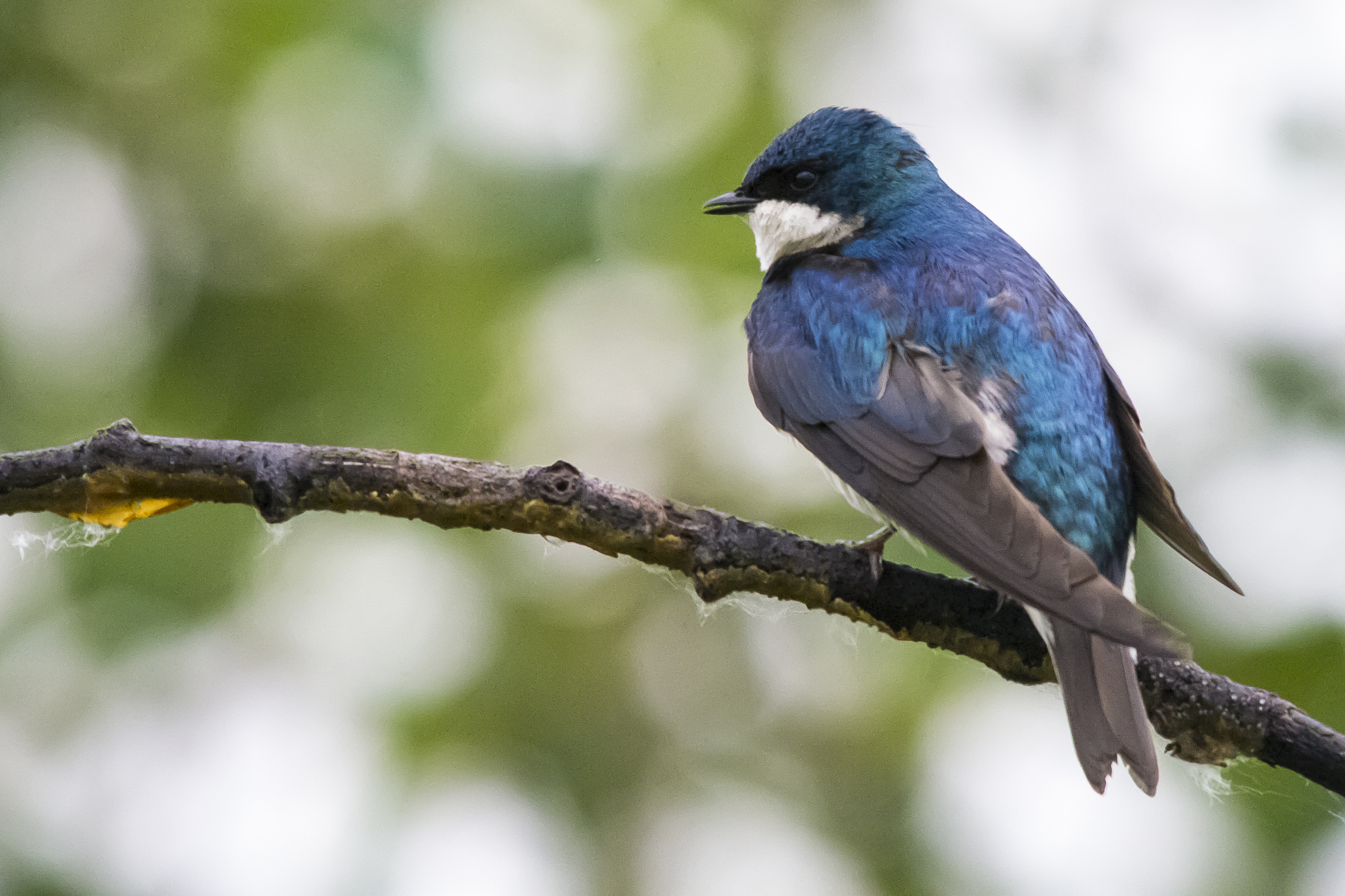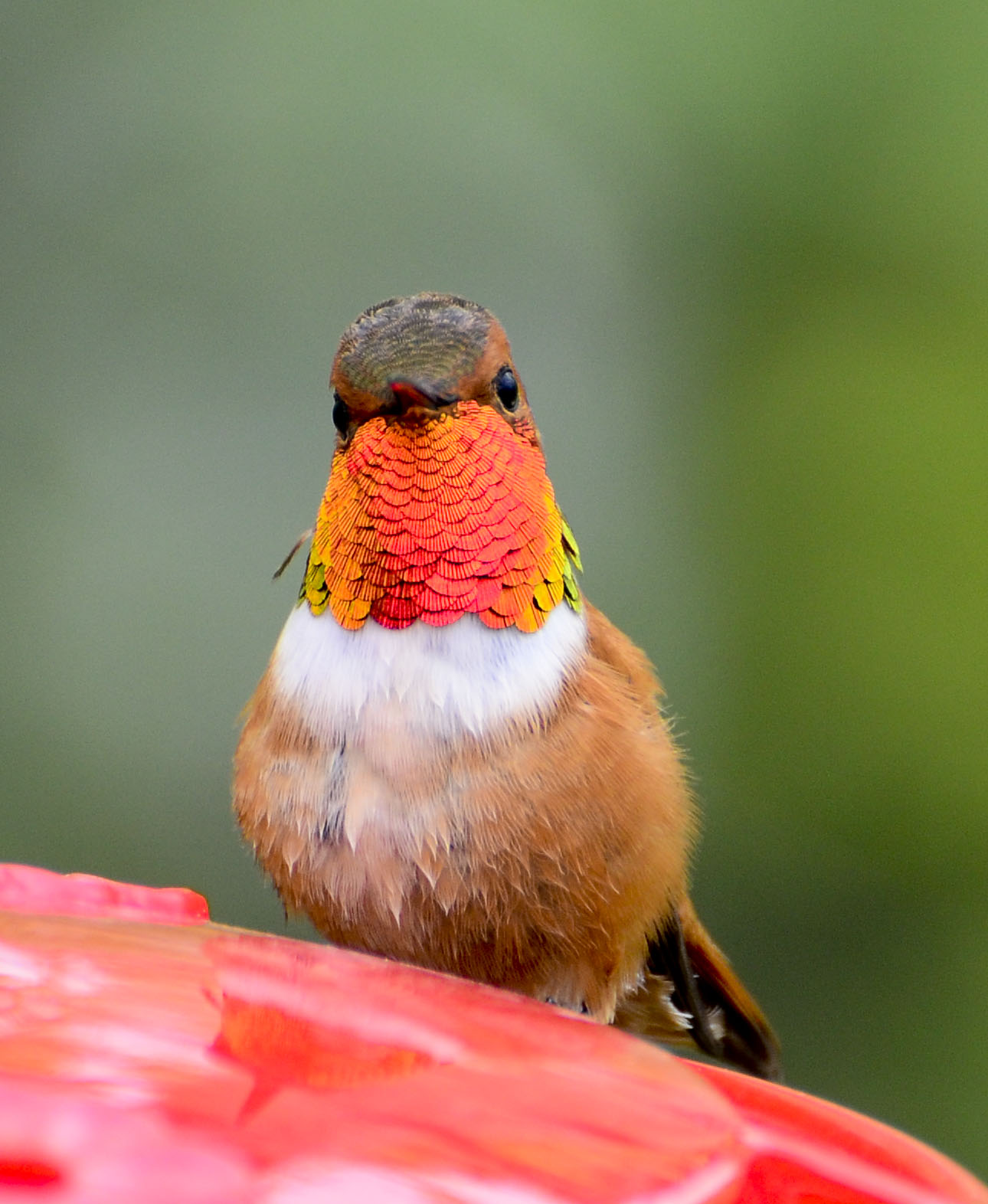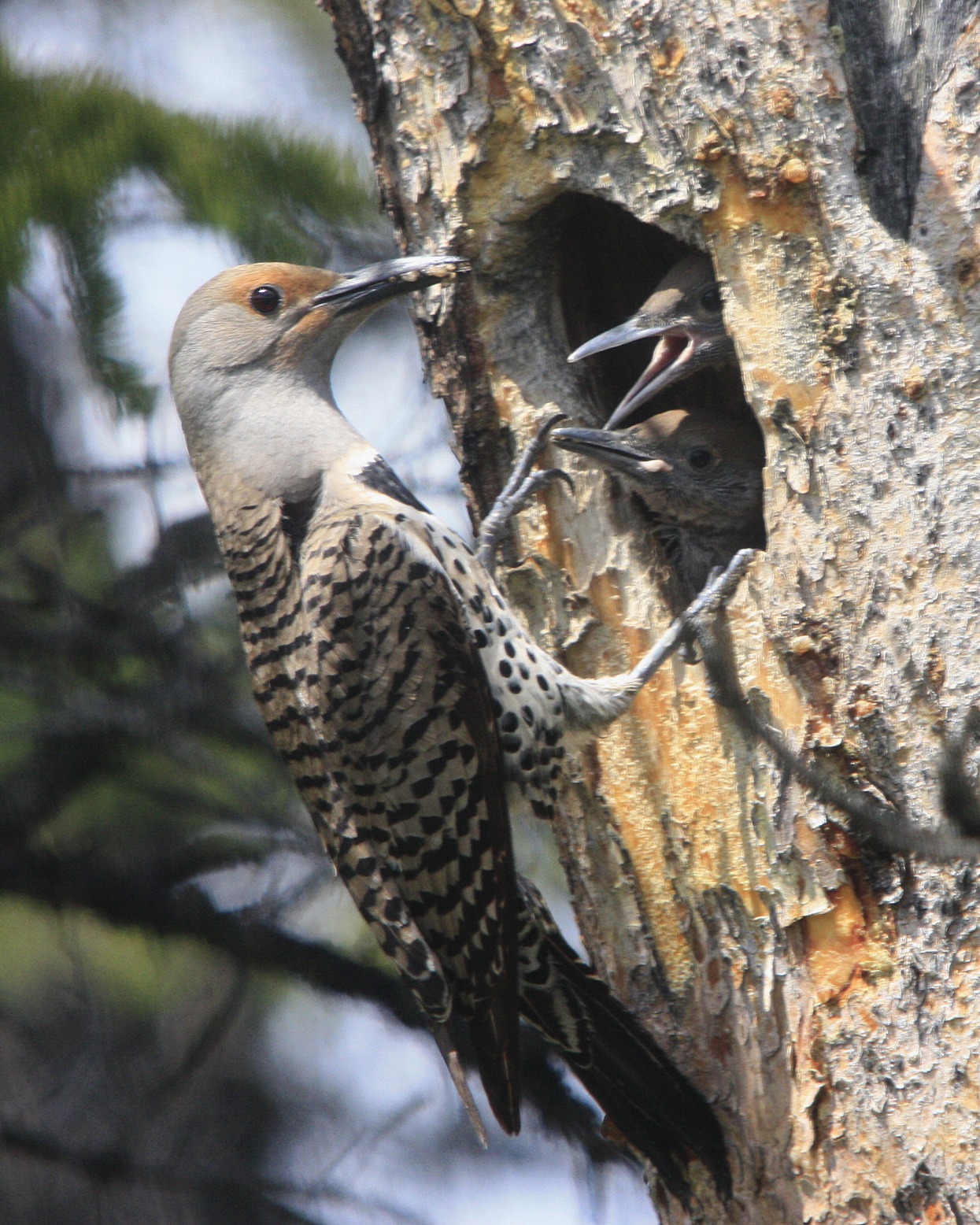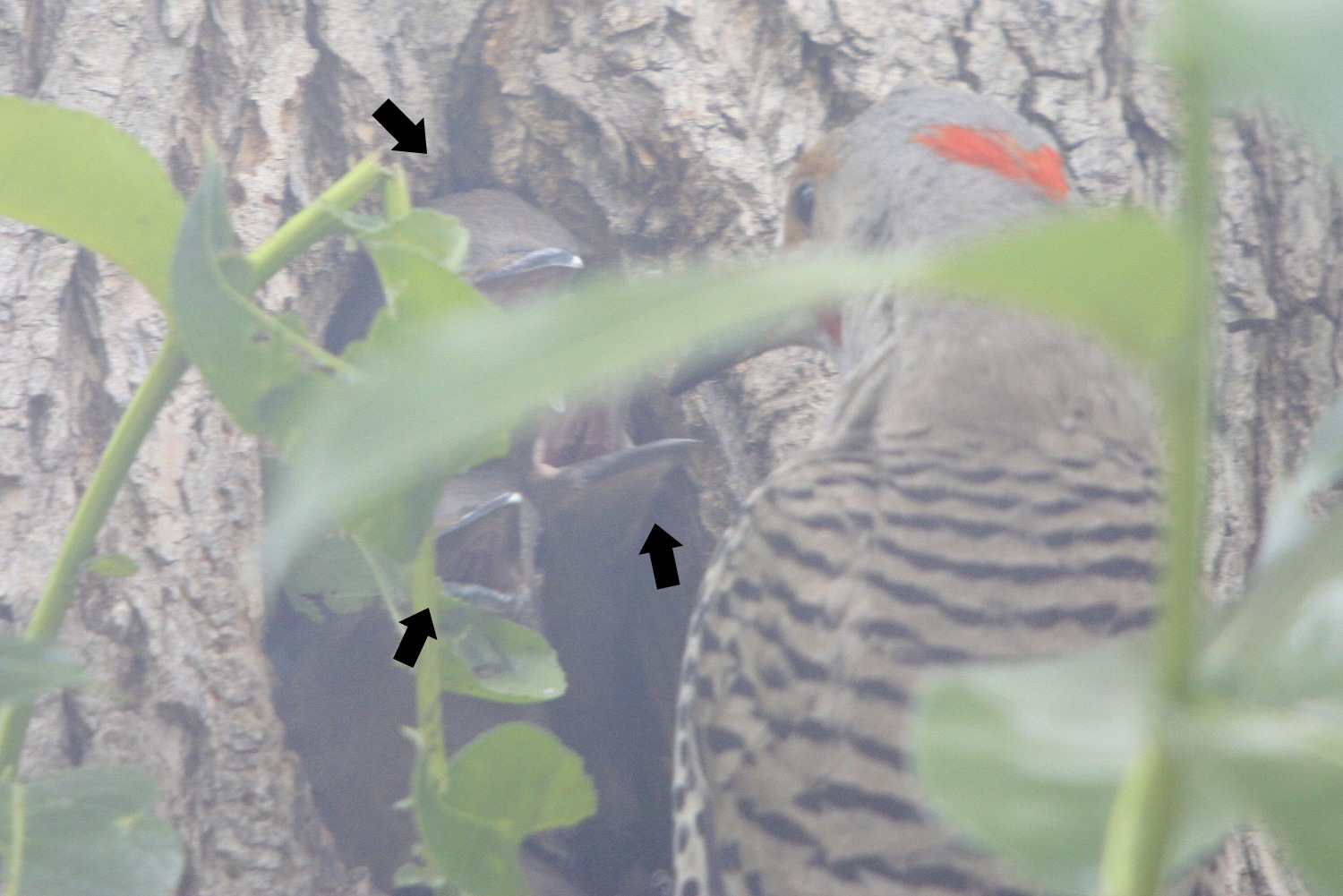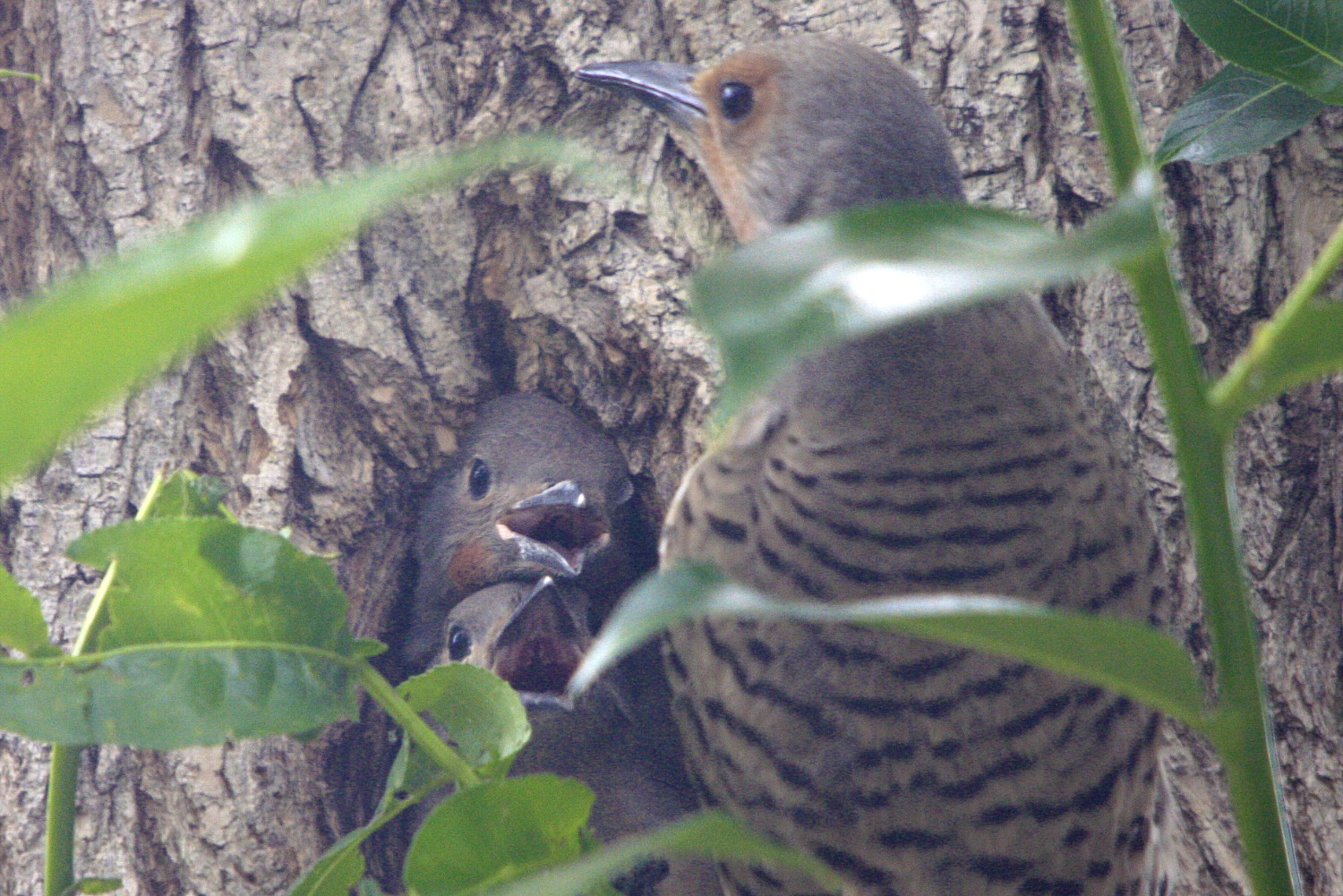Rob English photographed this beautiful bird that his wife spotted on Grand Valley Road in mid-July.
Archives
Lafarge Meadows – Flooding, baby birds, and a tern for the better
Posted by Dan Arndt
The final week of the Friends of Fish Creek Spring Birding course once again took us to the south end of Fish Creek Provincial Park, specifically, to the Boat Launch and south to Lafarge Meadows sloughs, which Matthew Sim has recently posted about. It was a good finish to a great course, and I am looking forward to joining a new group of fresh-faced and enthusiastic birders as fall migration is in full swing by September.
We started off with a new bird for our group (and for myself) for the year. Just north of the boat launch were a trio of American White Pelicans, one of which decided it was a bit too rainy for his liking and flew off before I took this photo. The water level both on the Bow River and in the sloughs adjacent to the pathway were incredibly high, and in some areas of the city, the weekend of June 24th was a time of some minor, or not so minor flooding. It seemed that the pelicans didn’t mind it so much, as they were seen regularly at this point all week long.
As we got looks at these gorgeous white birds, we couldn’t help but notice that a family of Tree Swallows had set up a nest inside one of the horizontal access gate poles. This male stood guard while the female was on the nest deep inside the gate.
Just south of the boat launch, on the west side of the path, there are normally three large sloughs on the north side of 22X. Because of the flooding, they all had merged into one incredibly large slough, and this Black Tern, along with three of its buddies, were making short work of the small fish, arthropods, and worms that were found within.
As we headed underneath the 22X bridge, and emerged on the other side, we stayed close to the river in hopes of spotting another of our target species for the day, the Western Kingbird. While not quite what we were looking for, this Eastern Kingbird was harassing (or being harassed by?) a Black-billed Magpie. Inter-species territorial disputes are always fun to watch.
While having great views of one species of the tyrant flycatchers is always good, not fifty meters away we were greeted by the sound of at least three Western Wood-Pewees harassing a family of Common Ravens, not to far from their likely nest site. Once again, inter-species territory disputes are the rule of the day!
As we headed further south along the river bank, we began heading into a bit more open grasslands and sloughs, and got much closer views of a number of waterfowl and other wetland birds. As we rounded one corner, we saw a Spotted Sandpiper give a bit of a broken wing display before flying up off her nest and, seemingly, abandoning it. We got some very good views of the nest, albeit brief, before moving off to a safe distance. We weren’t twenty meters away before the doting mother was back down on top of her clutch of eggs.
Meanwhile, this female Common Merganser was not about to leave her perch no matter how close we got to her. This is the same female and nest that Paul and I noted on the May species count.
The closer we got to the southernmost sloughs at Lafarge Meadows, the more the landscape changed from woods to grassland. Savannah Sparrows became the norm, compared with the Song Sparrows and Clay-colored Sparrows back to the north, and we even got a few good looks at a few Yellow-headed Blackbirds, clearly indicating that we were in a well developed wetland.
No visit to the wetlands in the spring would be complete without seeing the assorted ducklings, and we got quite a treat on that front! Not only did we see a trio of Common Goldeneye chicks, but also a female Hooded Merganser with her brood in tow!
And last but not least, this Blue-winged Teal was eager to show off his namesake, and sat patiently while not one, not two, but five photographers got good, clear shots of the blue flight feathers that inspired his name.
- Blue-winged Teal (male)
A great note to end off another great season of birding.
Over the summer, I have a number of various blog posts planned, mostly based around a few road trips and birding trips I have planned here and there. I look forward to sharing my stories and photos with all of you all summer long!
Good birding!
Sunday Showcase: Great Blue Heron
Sunday Showcase: Spring Birds of the Calgary Area
Here are some recent photographs of birds from in and around Calgary, by David Lilly. See more on the Canadian Bird Photographer website, and on David’s website.
Western Meadowlark
Tree Swallow
American Kestrel
Northern Shoveler
Blue-winged Teal
Cinnamon Teal
Wilson’s Snipe
Sunday Showcase: Rufous Hummingbird
Wednesday Wings: The Down in Downy
Posted by Bob Lefebvre.
I have three Downy Woodpeckers that come to my feeders regularly. They are not shy, and I managed to get some close-up photos that show the prominent nasal tufts of this species. These help to keep wood chips (and nut chips) out of the bird’s nostrils. It is sometimes said that Downy Woodpeckers are named for these downy feathers at the base of their bill.
Wednesday Wings: Swainson’s Hawks
Posted by Bob Lefebvre
On Monday I was in north Glenmore Park, and there was a pair of Swainson’s Hawks there. There was a stiff wind from the south, so I was able to get pictures as they soared almost motionless over my head. One of the birds is an intermediate to dark adult, and the other is a light hawk that looks like it is just coming into its adult plumage.
There was a little corvid harrassment…
Springtime in Carburn Park
Posted by Dan Arndt
Once again the Friends of Fish Creek Birding course made its way to Carburn Park, without the lure of the Northern Saw-whet Owl back in January. Since then, the weather has warmed, the birds have begun preparations to nest, and while most have chosen their mates, others are still in the process of defining their territory and competing with their rivals for the few mates still unspoken for. We were gifted with a few wonderful displays of an incredible number of Northern Flickers all throughout the park, as well as the beautifully crimson male House Finch, and huge numbers of Bufflehead, Common Goldeneye, Mallards, and Canada Geese.
This time around, we headed south from the parking lot to the bridge over the Bow River, which is one of the best places in the city to get good views, and good photos, of birds in flight. Both Canada Geese and the juvenile Bald Eagles came low over the bridge, almost posing as they flew by.
From there, we headed further south along the river to get views of the duck species present, and were allowed particularly good views of Buffleheads, Mallards, Common Goldeneye, and even my first female Common Merganser of the year.
We headed east about a hundred meters before heading north along the back fences of the community adjacent to the park. Here we were greeted by the melodious sounds of House Finches and Black-capped Chickadees at the feeders.
Cutting back over to the river bank, the overcast skies opened up to let the blue shine through, and the light was absolutely incredible for the better part of an hour. Along this stretch of river, we were constantly hearing the drumming and calling of the Northern Flickers, and across the river, a family of Bald Eagles was down on the ice. Overhead, the Canada Geese continued their flyovers before heading eastward to the outlying fields for the day.
From there, we headed along the shoreline in a clockwise direction. While the light remained good, we came across a curious Black-billed Magpie, and a group of Common Mergansers also swam in close, the males showing off their beautiful green head plumage.
While the number of ducks and geese was incredibly high, the evidence of their predation by the ever present Bald Eagles was apparent.
We continued to trek onwards, and in our search for the Northern Saw-whet Owl seen here in January that came up empty, we almost literally stumbled upon a herd of twenty or so White-tailed Deer, spread out along the trails in the northwest section of the park.
While the remainder of the walk was a little rushed, it remained relatively relaxing, as the birds had quieted down quite a lot, and none really seemed to pay us any mind as we strolled the interior of the park along the pond, back to our vehicles, and then home.
See you next week!
Wednesday Wings: Horned Larks
If you’ve taken any pictures of interesting birds in the Calgary region, you can share them with us by emailing birdscalgary@gmail.com and we may post them on the blog.
We received these amazing photos of Horned Larks from Joe Harley. Horned larks have been returning to the area for the past few weeks and can be seen along rural roads. They can be very hard to photograph but Joe got a few great shots.
Joe writes:
We’d like to compliment the writers of the blog; we enjoy all the articles (and photos). Thought I’d share the Lark family, photographed on Family day [February 20], not far from Kinbrook Marsh. That’s all I was able to get of the Larks. We were in the midst of photographing Pronghorns when the Lark opportunity occurred.
(click photos to enlarge)
Monitoring a Flicker nest
Posted by Matthew Sim
As spring approaches once again, I like to reminisce about the previous year and all of its most exciting moments.
For the past several years, flickers have nested in my neighbor’s tree. I had never really observed this nest closely before; however, last year, I did just that. Flickers usually excavate nest holes in dead or dying tree trunks or large branches. These nest holes are most often found at 6-15 feet off the ground and will often be reused. By late May/ early June in Calgary most flickers have laid their 5-8 white eggs. I started to notice that the flickers were more active around the nest in early June and it is my belief that on around the 3rd or 4th of June, “my” pair laid their eggs.

- This is the nest hole with the female looking out on June 10. The flickers had been in and out of the hole since late May
Incubation of the eggs ranges from 14-16 days and I had been closely following all the bird’s actions in attempt to discover when the eggs would hatch. On June 24, I heard the first sounds coming from the hole. The flickers had been born! I think that we can assume that there is a possibility that the young flickers were born a day or two earlier and I had not heard them until then.
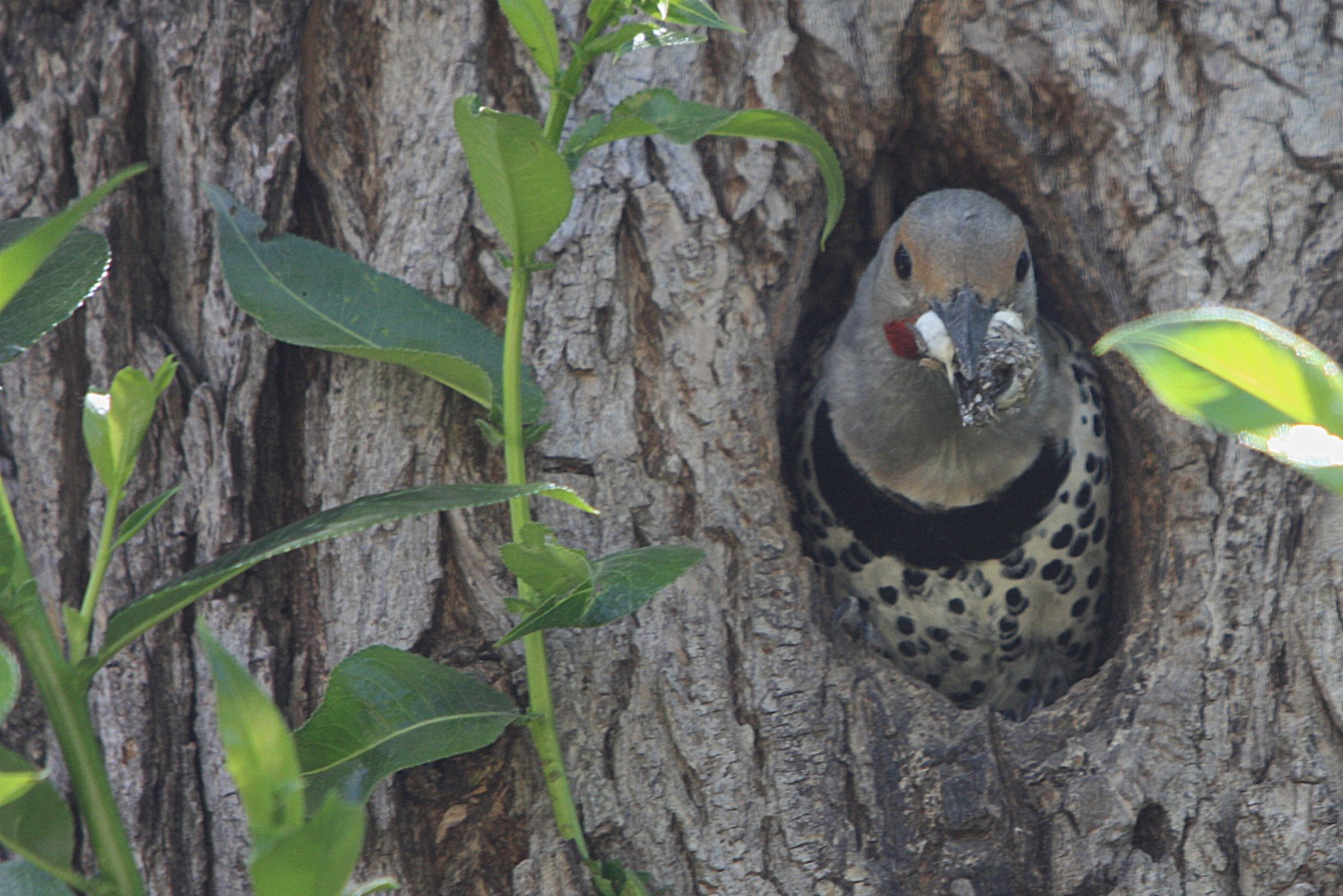
If you compare this shot with the photo above, you can see that the leaves around the hole grew a lot as the summer progessed, adding even more security and privacy to the flicker residence.
The first visible evidence of the young flickers was the clean-up crew. As all parents can attest to, there is a lot of cleaning up involved with kids. The adult flickers, both male (pictured in photo above) and female, had to work constantly to ensure that their young were well-fed, safe from predators and, perhaps most importantly, in a clean home.
July 1st came around and I had still not seen the young flickers, though I had definitely heard them. Each and every day they were getting louder and louder and soon I could hear them from across the alley, in my yard, maybe 35 feet away. The young flickers cry is often described as a hissing noise and is uttered for two weeks, day and night, growing stronger as the birds grow older. I was not worried about not having seen the flickers yet as their eyes do not open until they are ten days old, so wouldn’t be seeing them until then. July 3, I was up in Banff, where I happened upon a flicker nest with two young already poking their heads out of their hole. At that point, I couldn’t help but wonder how my flickers were doing.
July 5th, marked a special day for my monitoring project. That day, I got my first glimpse of the young flickers. I took my first photos of the young flickers on July 9th, and they were looking healthy and fit; all 3 of them!
But that’s where it went all wrong. The nest holes of flickers (and often of many other species of birds) are the scenes of very fierce battles. Three young birds with very sharp bills, duking it out for supremacy and the right to remain looking out of the nest hole, therefore receiving the most food. The stronger birds almost invariably end up on top, and maintain their authority by jabbing the others with vicious pecks of their beak. The opening is only big enough for two heads and the third one gets pushed to the bottom. There, the young flicker receives very little food and consequently, it perishes. July 9th, I took the photo above, showing 3 young flickers. By the next day, July 10th, I was only seeing 2 young flickers.
Disappointed though I was, I realized that sometimes, this is the way nature must work. I continued to watch the flickers for several days, amazed at the rate at which they grew. After about 4 weeks, the flickers would fledge and would begin to leave the nest; my flickers started appearing out of the nest around July 16th. The two young birds started hopping about and practicing flying, getting ready for the day when they would leave the nest altogether.
Than one day, I did not see the flickers. Nor did I see them the next day. Or the day after that. It would seem that the two young flickers that I had watched for a nearly a month had successfully fledged. I don’t think I ever saw these two again, though I was seeing flickers in the neighborhood, which might just have been one of the young. From time to time, I did hear the distant call of several Northern Flickers and I couldn’t help but wonder if it was the fledgelings, calling away.





